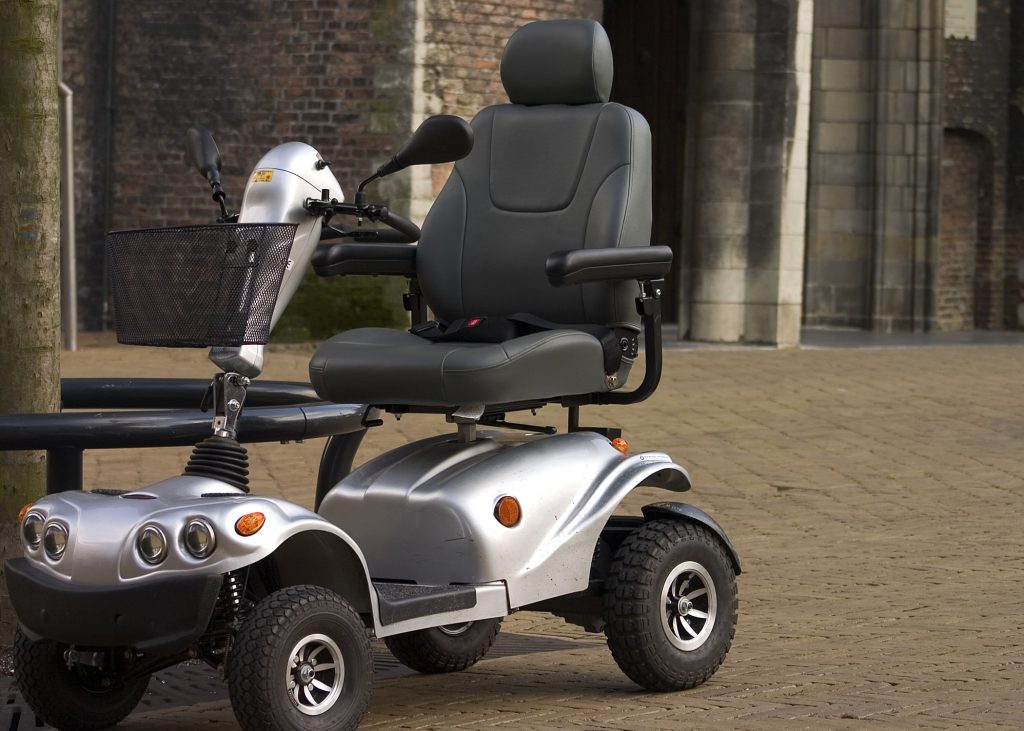Mobility Scooters vs Powered Wheelchairs
The mobility scooters vs powered wheelchair debate rages on, especially among those living with disabilities that hamper their mobility. These two mobility solutions contain pros and cons that make each suitable in specific situations. This blog explores those differences to help you choose the one most suited to your needs.
What are mobility scooters?
A mobility scooter is a powered vehicle that is ridden while seated and used by those with impaired mobility. Mobility scooters share similarities with powered or electric wheelchairs, especially their overall purpose. However, they have several design differences and, therefore, applications.
Features of mobility scooters
- Storage compartment
Mobility scooters are equipped with a basket and other storage compartments in the front, back, and under-seat section, depending on the design. These increase the scooter’s functionality and further increase your independence. Therefore, you can go shopping, take your pet with you, and even have storage space for other mobility aids. Some scooters also offer extra room to fit other storage compartments.
- Battery indicators
These scooters also have a battery indicator that reveals what range is available. Therefore, you can schedule your excursions with peace of mind, knowing you won’t be stuck with no charge.
- Security features
Most mobility scooters have keyed ignition, ensuring only you can use it. Additionally, some have alarm systems to alert you and others in case of attempted theft.
- Freewheel mode
Mobility scooters should be easy to move about, and most of them have freewheel mode. Freewheel mode allows you to disengage the drive mechanism and push or pull the scooter freely. This feature comes in handy when you can’t power up the scooter, the drive mechanism develops a problem, or you run out of power.
- Lights and signals
You may find yourself outside when it gets dark, and lights will prove helpful to give away your location and enable you to see the way. Turn signals are also handy as you share the road with other motorists.

Pros
- Excellent use on the road
- Ample storage space
- Excellent range from the large capacity batteries
Cons
- The heavy battery that needs regular charging
- Less stable than a powered wheelchair
- Heavy and bulky unit
- Cannot fold
- Limited indoor use
- More expensive than a powered wheelchair
What is a powered wheelchair?
A powered wheelchair is a wheelchair that relies on electric propulsion as opposed to your arms. Most have a joystick for easy manoeuvring, suitable for those with upper body strength deficiencies or still weak from recovery.
Features of powered wheelchairs
- Padded seating
Those who use powered wheelchairs tend to sit in them for long periods, which makes a well-padded seat a necessity. Besides keeping them comfortable, the seat absorbs all the shock from rough terrain.
- Ample leg room
Powered wheelchairs either have a wide legroom section or leave that section free, similar to manually operated wheelchairs. This makes getting on and off the wheelchair easier and more convenient. Additionally, such leg room adds to the comfort levels.
- Storage space
Depending on the design, a powered wheelchair may have plenty or little storage space, but there’s always some. Storage space is necessary for holding other mobility aids or for daily activities like shopping.
- Adjustable back
Powered wheelchairs go over different terrain and terrain gradients. Therefore, it is important to adjust the back angle for comfort and ease of movement. Additionally, adjusting the back angle helps relieve your body of discomfort from holding one position for too long.
- Portability
Most powered wheelchairs retain the portability of manually-operated chairs, which is handy for those who often switch between the chair and a car. The lightweight, collapsible and portable design makes using the wheelchair easy and possible for a person with a disability.

Pros
- Foldable
- Collapsible
- Lighter than a mobility scooter
- More comfortable seats
- Cushioning and overall design allow for better rough terrain response
- More stable than a mobility scooter
- Excellent use indoors
- Height adjustable seating
Cons
- Limited range in outdoor use
- Not the easiest machines to control
- Heavier than manually-operated wheelchairs, it may be too much for some
Which one is the best for you?
Choosing between these two mobility aids comes down to the level of mobility impairment you suffer. Other factors like comfort level, price, storage space, and range may influence your decision. However, those with a severe disability should pick the powered wheelchair, and those with minimal mobility issues should settle for a mobility scooter.
These mobility aids are crucial for those with disabilities. Whichever mobility aid you pick, ensure you can afford its price plus insurance, it is comfortable to sit in and control, and it’ll serve your needs as long as your mobility remains impaired.


